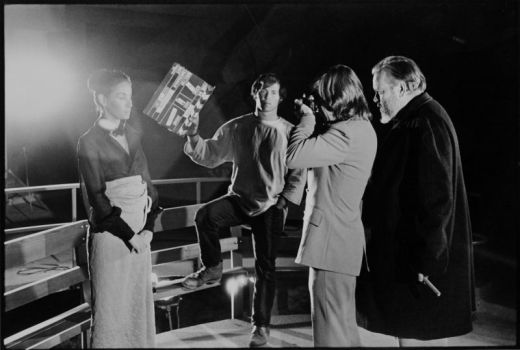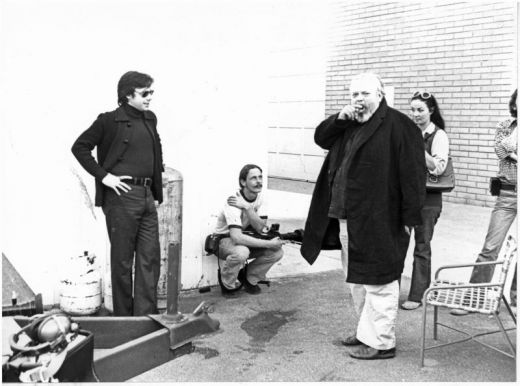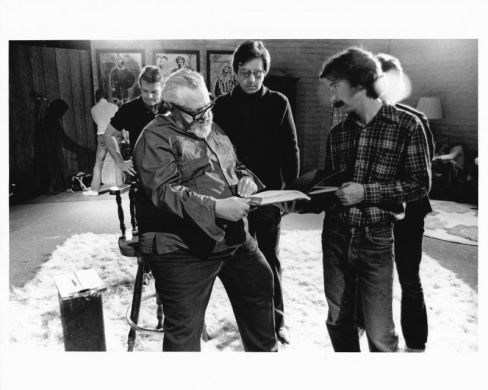
Photo credit to Lauren Faretta
Born on December 29, 1977, Filip Jan Rymsza is a Polish-born filmmaker and writer. He emigrated to the United States in the mid 80s, first settling in Chicago where he studied economics and philosophy at the University of Chicago. He currently resides in Los Angeles. During the 68th Cannes Film Festival, Filip announced to press the recent Indiegogo Campaign initiated to raise money for the finishing of Welles' last and never before seen film, 'The Other Side of the Wind'. At the time of Welles' death, the film was surrounded by a “Byzantine legal wrangle”, as Filip describes it, and was left unfinished in Paris archives since 1976. With the help of the money raised through Indiegogo, the aim is to finish the film in 2015 (the centenary year of Orson Welles birth) for all the world to see.
You started working on this film six years ago, and when you found out the rights were available this became your passion project?
Yes. It was exactly six years ago in Cannes when I first found out the rights were available and it became a passion project over time. To know the rights were available was an understatement because at first it was a process where I tried to acquire as much information on it as possible and then tried to find an entry point. It had a very sordid history from a legal standpoint because it was like a Byzantine legal wrangle, especially in France. Then trying to have a game plan of how to tackle that position of all these rights, how to approach every person and try to find out what was motivating them. Everyone had a shared purpose; everyone wanted to see this film done. It was showing them a method by which it could be done and that took a long time.
What were all the legal issues that stopped this film from getting made?
Back in the day, Orson Welles was self-financing. This was a project he thought would be a comeback film of sorts, and there is a certain amount of irony to it because it's about a director who is also making a comeback film. Orson wanted to retain control. He had been spurned by so many other productions, by investors, by studios, and for him control was the most important factor in anything he was going to devote himself to for so many years. He needed to take acting jobs to be able to finance the film so the production period was long. Then he found a backer but they had a falling out after years. It was also all the things that can't be foreseen, like the Persian Revolution which was something that tied up a lot of the investor's assets. The investor was very patient with Orson but he wanted him to deliver by a certain date and Orson never liked to work within constraints. From that point forth, once that became an issue for them, the next 5-6 years he was editing while also looking for a buyer to buy out the brother in law of the Shah. Orson didn't have access to all the materials as the negatives were under court order in Paris. He had smuggled out the rush print and was editing off that. There are many factors in a situation like this. What he left behind was forty minutes of non sequential film, an assembly, five linear scripts, memos to editors with a wealth of information.
Who has possession of the negatives today and where are they exactly?
Oh, that's a book you're asking from me. The negatives have been in archive in a place outside of Paris since the original production period. The last inventory that I saw was 1974. Then in October of last year we finally did another inventory to make sure all the elements were there and everything checked out, which was a huge relief. But that was the first time we were able to take a look at the materials other than just knowing they were somewhere in a vault and had to gain access to them. That's when we announced last Fall that we had acquired all the rights and we were able to go in with technicians to take a look at the film itself and gauge its condition. We were very pleasantly surprised and relieved to know that the film was in mint; it had never been handled since the 70's. It was kept in great condition which was a great thing after all the anxiety. The cinémathèque française are very passionate about preserving film and this was a very important project to technicians like that who handle these things every day; when I saw their smiles I knew it was great and we were in good shape.
Why wasn't the film completed in time for Orson's 100 year birthday anniversary coinciding at Cannes and presented to Cannes for competition or official selection?
That's the goal, to finish this year. We wanted to finish the centennial year. I think we got misquoted in the press and it ran that we would finish it with the centennial so everyone said “May 6” on the day but this wasn't something that was ever deadline driven because we simply don't know. There were always way too many unknowns. The Indiegogo campaign became something we were discussing internally in November/December so this has been in the works for a while and we wanted to time that with the birthday. We talked to Orson's daughter and she had this idea saying, “Wouldn't this be a wonderful present for my dad to be able to finish the film for him?” And we thought that would be compelling for the Indiegogo campaign and there would be attention. We need the attention because it's a film that at this stage we need Orson's fans and art lovers to come and contribute to. Also we are raising awareness because a lot of people know about the history of the film and know we are completing it but they don't realize we have a campaign that will enable us to do it the way we want.
Now that all those legal battles are over and the film is getting closer to finishing, do you have any ideas when the film be completed and where will it premiere?
I mean of course we have a calendar but there are still way too many unknowns. We are not committed to anything. We really just want to do what is right for the film and that has always been our mandate. Once we get it to rough assembly then we will know what we are dealing with and what else needs to be done. For instance, some of the sound elements need work because in some areas Orson is reading John Huston's lines and then when they did off-screen dialogue, John recorded. So, if there is something that's missing then we have to bring in Danny Huston who does a great impression of his dad. There are so many unknowns, little elements like that which make it very difficult to project when we will finish it. What I can tell you is if we reach our goal, that will enable us to finish it this year. If we fall short then we have to get creative and find out where the financing is coming from. This is a film that is very expensive for what we are doing because it's not a re-release, it's not a restoration, it's a new movie. It's going to be a 2015 film and Academy Award eligible. So, Orson Welles can have a nomination for Best Director.
It could very well be that Welles' is still changing cinema from the grave. He introduced the Flashback and now he will have a film released decades after his passing. Plus the fact there are so many layers to the irony of this film. Do you think this film could end up at the Academy Awards?
Absolutely! And we are doing the documentary alongside of it because it needs a companion piece; it's the history of it which is so fascinating. It's the meta aspect of it, the irony of Orson doing a comeback film about a director doing a comeback film who dies before he's able to finish the film. This film is so far ahead of its time. Nobody understood him and that was the great artist who is a self-destructive business man. You know, he definitely got in his own way a lot in his career and he left things in a difficult state trying to piece together all the rights. That's something that troubled him throughout his career. He fought especially at the end because many things had been taken away from him and did him such emotional harm that he became so controlling, almost paranoid to the point of always wanting to make sure he had control of the film up until release to put his final stamp on it and say, “This is my vision.”
That's incredible! Producer Frank Marshall must be ecstatic about finally seeing the completion of this?
Well, he's ecstatic to see it to completion and have some finality in his career. Same with Peter Bogdanovich. He's just waiting in LA the whole time asking, “When are the next materials coming?” They are both thrilled because this has been a long journey for both of them. My six years compared to their 45 years is nothing. I personally am extremely proud. From five years ago this was something very dear to me and became more so the closer I got with everybody, like Orson's daughter who I became close with. We share a purpose and we come up with these ideas we want to see through. We all can't wait to get to the last stages where it's purely creative, and then to the release. We are fascinated with how we will be able to market this film. The history of the film is so compelling and right now it's a shift from saying the focus is not only on the history of the film, which is very rich, but it's on the future to be able to finish it and have this campaign be successful. It does say quite a bit because we want to know there is an audience for it, that the more contribution we have reflects there is an appetite for this film in the marketplace. It will certainly help with the distributors we have been talking to, some who are handpicked, so the release will be in keeping with the way Orson wanted it and give it its due. The film needs to go theatrical and be seen the way it would have in the 70's. We want it to best resemble how Orson would have finished it in the 70's.
Do you have a sales company and were pre-sales being sold at Cannes?
We are not selling the rights yet. What we want to do is finish the film and be able to show something as compelling as possible because what everyone had seen were the bits and pieces Orson had left behind from the working print which he fed with the usual scratch of cigarette marks and grease pencil all over it; to show that print to someone, they think that's what they will get with the finished product. But having seen the negative, having done the scans for it and knowing how gorgeous the negative is, we felt that we will be doing ourselves a disservice if we would be selling this on the basis of that work print. That's why this Indiegogo campaign was so necessary, because this gives us the means to go to distributors and say, “this is what the finished product is going to look like.” Whether that will be a clip or a finished film that depends on who and at what point in time. Obviously that's in keeping with the way Orson went about films, that kind of anti-establishment “I want to hold onto this and do it my way for as long as I can and only give release when it's done.”
Why does the film need so much money for post production ($2M on Indiegogo)?
The $2M we are trying to raise is just a fraction of the budget. To finish the post it will include the technical completion but also things like music licensing, the scoring and things Orson wanted. All that is an expensive process but we aren't even talking about everything that came before this, which was the acquisition of all the rights and everything else. The only way for us to really do this was to come in and assume everything and let us finish it the way Orson wanted it and not having any kind of oversight, using the blueprint laid out by Orson. We want to raise awareness for the film. We knew it would be a grass roots thing and we wouldn't have all the money on day 1 and day 2, so we are introducing new perks every few days as we go. But Indiegogo gave me data and usually it's 1 in 100 people who visit the site contributes, but we started off 1 in 7 which was off the charts. Our messaging is great, it's just people are not finding their way to the site so we need to get the message out there.

Photo 1 Photo Caption: Orson Welles, far right, in 1971, filming Oja Kodar in “The Other Side of the Wind” with Producer Frank Marshall (with slate) and Cinematographer Gary Graver. Photo Credit: Photograph by José María Castellví

Photo Caption: From left, Peter Bogdanovich, Bill Weaver, (seated), Orson Welles and Oja Kodar on location during the filming of Orson Welles' last unfinished film “The Other Side of the Wind." Photo Credit: Photograph by José María Castellví

Photo Caption: Orson Welles, (far left) on location during the filming of Welles' last unfinished film 'The Other Side of the Wind,' discussing a scene with Peter Bogdanovich (second from left) and Neil Canton (holding screenplay). Photo Credit: Photograph by Larry Jackson
About the Film: THE OTHER SIDE OF THE WIND is a scathing tale of friendship, betrayal, media and ambition in Hollywood that unspools as a fast-cutting, kaleidoscopic film-within-a-film. It’s the last night in the life of Jake Hannaford (John Huston), a once-legendary director trying to finish a sexy, edgy film intended to reinvent his career. In a series of encounters with reporters, studio heads, members of his entourage, acolytes and enemies, elements of Hannaford’s art and life come to the fore. The all-star cast includes cinematic legends John Huston, Peter Bogdanovich, Oja Kodar, Robert Random, Lilli Palmer, Edmond O’Brien, Cameron Mitchell, Mercedes McCambridge, Norman Foster, Dennis Hopper, Paul Stewart, Peter Jason and Susan Strasberg. The film is being produced by Filip Jan Rymsza, Frank Marshall and Jens Koethner Kaul.
About Indiegogo: Indiegogo empowers people around the world to fund what matters to them. As the largest global crowdfunding platform, campaigns have launched from almost every country around the world with millions of dollars being distributed every week due to contributions made by the Indiegogo community. At its core, Indiegogo is an open platform dedicated to democratizing the way people raise funds for any project–creative, entrepreneurial or cause-related. The company was launched in 2008 and is headquartered in San Francisco, with offices in Los Angeles and New York. For more information, visit www.indiegogo.com and follow us at www.twitter.com/indiegogo and www.facebook.com/indiegogo.
Join the campaign on Indiegogo https://www.indiegogo.com/projects/other-side-of-the-wind-orson-welles-last-film/x/4216615
Like us on Facebook https://www.facebook.com/pages/Orson-Welles/432784776893981
Follow us on Twitter http://https://twitter.com/OrsonWelles
Visit us on http://www.orsonslastfilm.com
Interview by Vanessa McMahon; posted May 28, 2015




















